Description
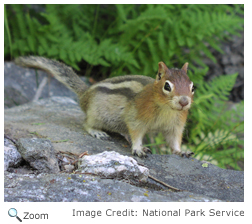 The golden-mantled ground squirrel is a small chipmunk-like squirrel with grayish-brown fur on top with two white stripes bordered by black stripes on its sides. It has a lighter underside. Its head, face, front paws, and chest are a coppery red. The golden-mantled ground squirrel is a small chipmunk-like squirrel with grayish-brown fur on top with two white stripes bordered by black stripes on its sides. It has a lighter underside. Its head, face, front paws, and chest are a coppery red.
Range 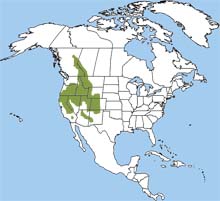 The golden-mantled ground squirrel can be found from southeastern British Columbia in Canada south to Arizona, New Mexico, and Southern California. The golden-mantled ground squirrel can be found from southeastern British Columbia in Canada south to Arizona, New Mexico, and Southern California.
Habitat 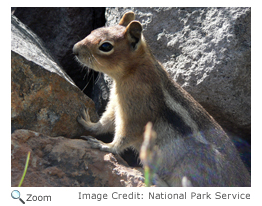 The golden-mantled ground squirrel is found in coniferous and mixed coniferous-hardwood forests. It is common in mountainous areas up to the timberline. It is also found in places with rocky meadows and in sagebrush areas. The golden-mantled ground squirrel is found in coniferous and mixed coniferous-hardwood forests. It is common in mountainous areas up to the timberline. It is also found in places with rocky meadows and in sagebrush areas.
| |
Diet 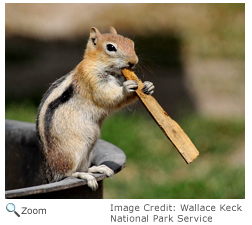 The golden-mantled ground squirrel eats seeds, nuts, and fruits. A large part of its diet is made up of piñon nuts. It also eats green plants, some insects, and underground fungi. In the fall, the golden-mantled ground squirrel puts on a layer of fat. It hibernates from October to May. It has cheek pouches that it uses to carry food. It takes food to its den and stores it to eat in the spring when it wakes up. It may wake up a couple of times during hibernation and eat the stored food. It makes its den near or under a tree or log. Its den isn't dug very deep, but it can stretch as long as 100 feet. The golden-mantled ground squirrel eats seeds, nuts, and fruits. A large part of its diet is made up of piñon nuts. It also eats green plants, some insects, and underground fungi. In the fall, the golden-mantled ground squirrel puts on a layer of fat. It hibernates from October to May. It has cheek pouches that it uses to carry food. It takes food to its den and stores it to eat in the spring when it wakes up. It may wake up a couple of times during hibernation and eat the stored food. It makes its den near or under a tree or log. Its den isn't dug very deep, but it can stretch as long as 100 feet.
Life Cycle 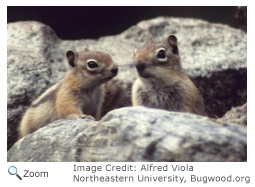 Mating season is in the spring when the squirrels come out of hibernation. The males emerge first and compete with each other to establish a territory. Females come out of hibernation two to three weeks after the males. The female builds a nest of leaves, grass, and bark in an underground burrow. A month after mating, she has a litter of between four to six babies. The babies are born with their eyes and ears closed, and they are hairless except for tiny whiskers and fur on their heads. After about a week, their fur comes in. The female cares for the babies. They wean when they are about a month old. Mating season is in the spring when the squirrels come out of hibernation. The males emerge first and compete with each other to establish a territory. Females come out of hibernation two to three weeks after the males. The female builds a nest of leaves, grass, and bark in an underground burrow. A month after mating, she has a litter of between four to six babies. The babies are born with their eyes and ears closed, and they are hairless except for tiny whiskers and fur on their heads. After about a week, their fur comes in. The female cares for the babies. They wean when they are about a month old.
Behavior
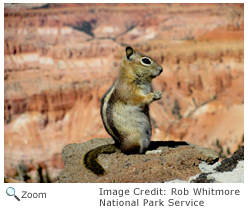 The golden-mantled ground squirrel cleans itself by rolling in the dirt and combing its fur with its teeth and claws. The golden-mantled ground squirrel cleans itself by rolling in the dirt and combing its fur with its teeth and claws.
|